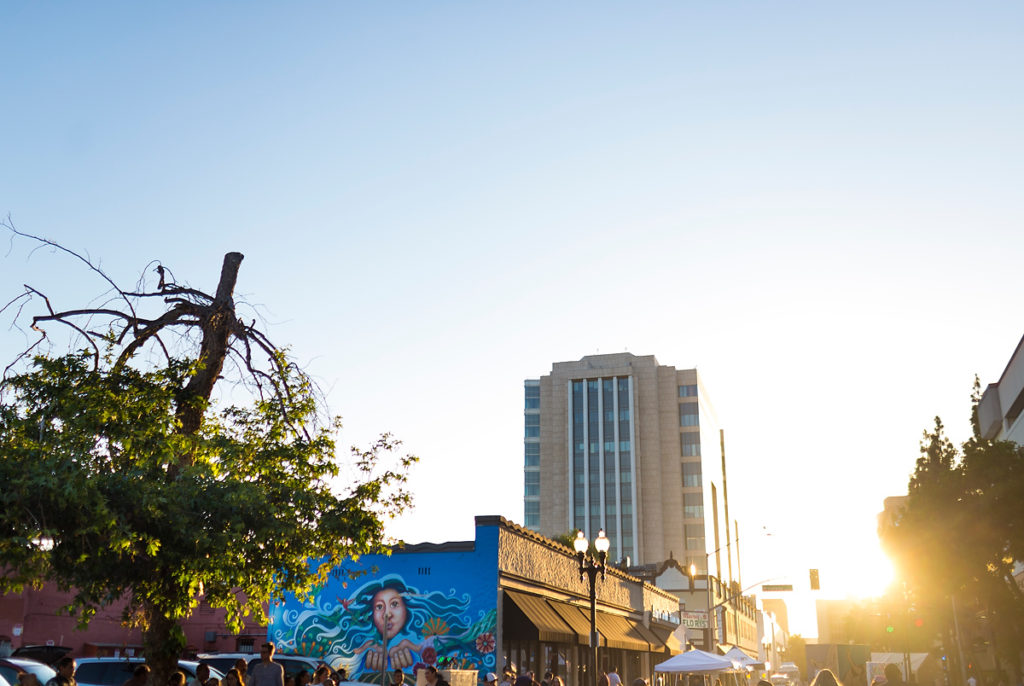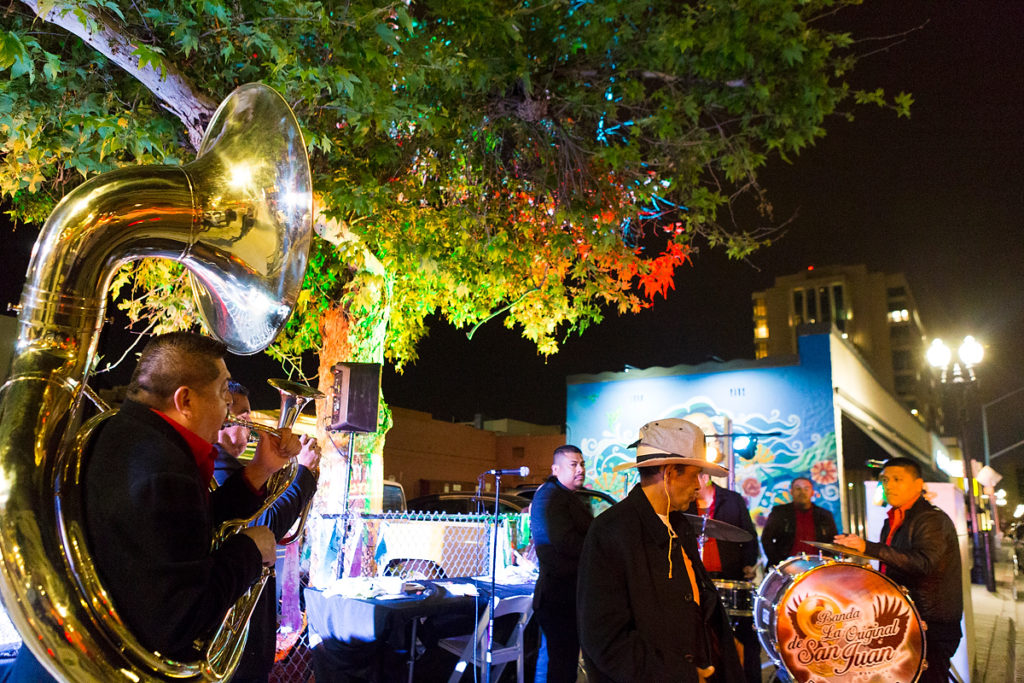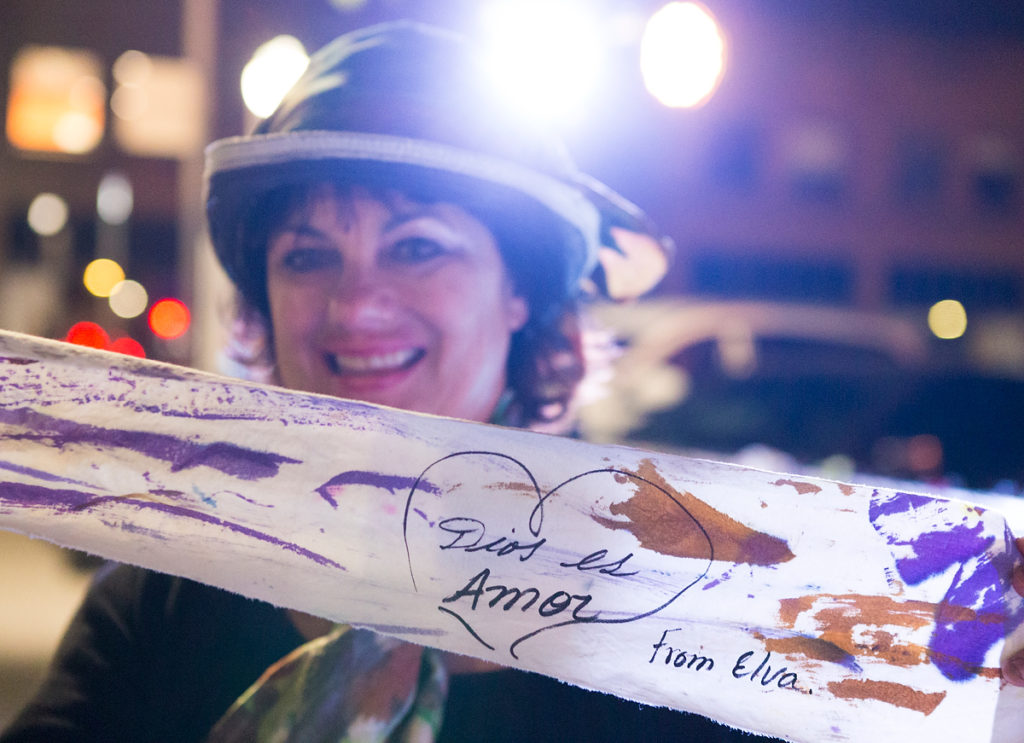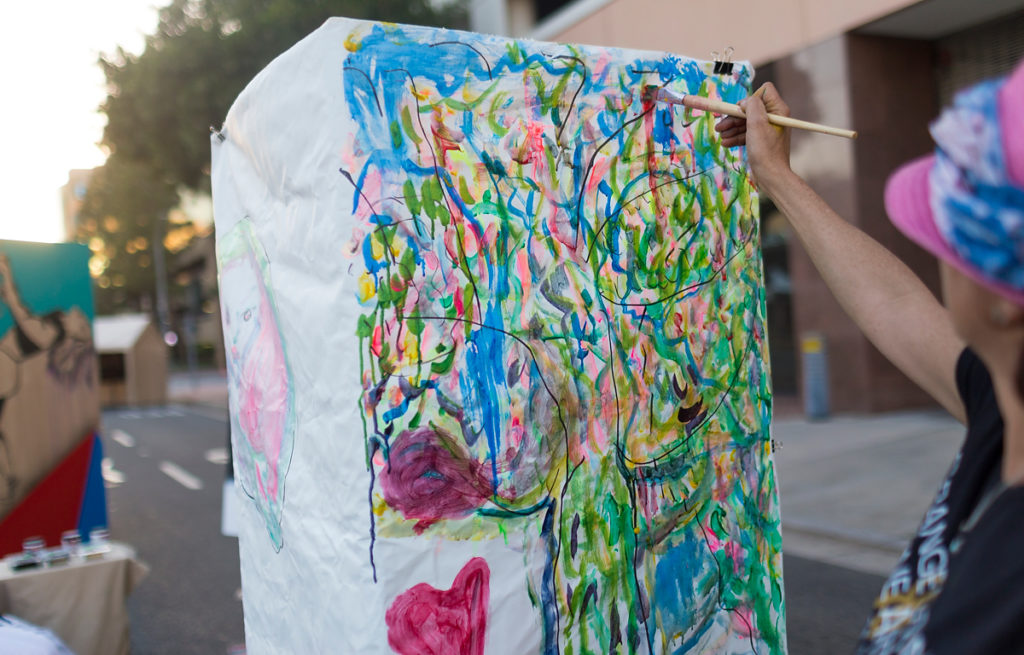Santa Ana’s Calliotree
This story is supported by a National Endowment for the Arts Our Town Knowledge Building grant supporting a partnership between Springboard for the Arts and the International Downtown Association. See more stories from the partnership here.
The story of the birth of the city of Santa Ana goes like this: in 1869, 40 year old William H. Spurgeon climbed atop a sycamore tree to survey the 76 acres of land he had recently purchased in California’s Orange County. Enamored by the mustard field valley he saw below him, Spurgeon decided to start a town, making the sycamore tree the birthplace of the city of Santa Ana. Since Spurgeon’s climb, the city has gone through booms and busts and undergone a huge demographic shift while welcoming new generations into its arms. Presently, the city boasts a majority Latino population with a huge cultural and economic presence and is home to one of the most vibrant art scenes in Orange County. Amidst all these changes, Spurgeon’s tree seemed to have been forgotten about. That was until Ryan Smolar, Lead Consultant at Downtown Inc Santa Ana, heard about the tree.
At a council meeting last year, Smolar heard a Santa Ana resident complain about the disgraceful condition of the tree from which the city had sprouted. This was the first time Smolar, originally from Los Angeles, had heard the story of the city’s foundation. He made a mental note of it. Later, driving in downtown’s North End area, Smolar remembers, making a left and seeing a giant tree come into view.
“It was the ugliest tree I’ve ever seen,” he recalls. “I remember thinking, ‘what’s wrong with that tree?”

This, it would turn out, was Spurgeon’s sycamore tree, underneath which sat a small plaque honoring the city’s birthplace. While the original tree had been cut down decades ago, a replacement tree had been planted at its site in 1976. This was the tree Smolar was looking at, which sat fenced into a parking lot and appeared to be dying. For Smolar and Downtown Inc, an organization charged with facilitating the enhancement of Downtown Santa Ana, the birthplace of their city was long overdue for some extra attention. Located in one of Santa Ana’s Art Districts and home to the Artwalk (a popular monthly arts event), the tree was perfectly primed for a reintegration into the city’s hearts and minds.
With grant funding, Smolar took the lead on a project to honor the tree. Working with Arman Bastiani, an artist-engineer, Downtown Inc envisioned a public art installation that would hug the tree in digital arts, music and human touch, turning it into an interactive instrument for the residents of Santa Ana. In this way, they came up with the Calliotree, the name, in part inspired by the Calliope musical instrument invented around the same time of Santa Ana’s foundation.

In initial consultations, it became clear to Smolar that a project like this needed community input because after all, it was about the city’s past, present and future. According to Smolar, “I wanted people to be a part of this, so it didn’t just appear. We wanted to include people we knew and people who maybe we didn’t know.” This inclusion would be crucial in honoring each of the city’s inhabitants: from residents whose families had lived in Santa Ana for over a century to the wave of Latino immigrants who had established homes here two generations ago to the artists and creatives now adding to the tapestry of the city. The Calliotree would represent all the ways in which these communities had come to coexist.
While Bastiani worked on the design for the installation, Downtown Inc partnered with local artists to plan two community engagement events preceding the launch. The first, would be a community dialogue dubbed Treeversation. Held in March of this year, during Artwalk, Treeversation was led by mixed media and textile artist, Leah Shapi. Individuals who approached Shapi’s table learned about the history of the tree and using fabric markers, wrote down their inspirations, ideas and hopes for the project on colorful scarves. To bring added attention to the event, Downtown Inc projected colorful lights onto the sycamore tree and even had a mic stand where individuals could read what they had written to the tree. While unconventional, the Treeversation was successful in getting people interested in the tree’s significance to Santa Ana’s history. According to Smolar, “That was really exciting. People would stop and want to know about the tree and we would tell them about it and they would one hundred percent retain the story.”

For Shapi, a self proclaimed tree lover, the Treeversation provided an opportunity to engage with the community in a different way. “With everything going on in the world,” she states, “it had a real warm and fuzzy feeling in people’s hearts. We had people from all different backgrounds; kids, adults, different nationalities just playing with the idea of what they wanted to put on the scarves.” Down the line, Smolar hopes to sow the cotton scarves into a tapestry, further commemorating the tree.
The second community engagement event, held during April’s Artwalk, was an open music jam session called Treeprov. Downtown Inc envisioned the event as an invitation for artists to explore uses for the Calliotree while drawing visitors to downtown’s North End. For Treeprov, Smolar partnered with local businesses on the street where the tree is located to create a closed off event featuring food vendors, live music, live painting and a drum circle, among other attractions. To round it off, an arts group, The Warehouse of Contemporary Art, created projections of the tree onto a wall behind it adding to the aesthetic of Treeprov.
Through these two events, Downtown Inc, was building community knowledge around the tree and learning along the way. For instance, Smolar found out that the tree had been used as a meeting site by a neighboring business, for years, believing that it held good fortune. In addition, while Downtown Inc had been led to believe that it was dying, two unexpected things happened over the course of the project. One, it appeared that the more the community engaged with the tree, the more it seemed to come back to life. Of course, it didn’t hurt that the last few months had brought much needed rain to the area.
“We thought the tree was dying and all of a sudden, since I’ve been involved in this project and the community has been showing love for the tree, all these leaves are growing on it,” Shapi states.

Secondly, after consultations with Mike Lopez, the city’s Parks and Recreation Arborist, Smolar and his group discovered that in fact the tree was not completely dying. While its top was dead, the tree had started to grow sideways. This is where all the new leaves were sprouting, on what appeared to be giant branch, but in actuality was the tree growing sideways. It turned out the tree could be saved through a grafting process that would allow it to continue to grow upwards.
On the first Saturday of May, and the third Artwalk event of the project, the completed Calliotree was unveiled. While the artist-engineer’s initial designs had to be scaled back for a number of reasons, the main elements of the design remained. Featuring bluetooth amps and sound synchronized lights, the Calliotree was ‘played’ by local sound and visual artist, Sean Robertson. Lights projected “The Calliotree” onto an electric box, glowing seats were set out on AstroTurf inviting passersby to stay a while and on a small movie screen, a mini-documentary about the project played. Despite a steady rain all day, the event accomplished its goal, inviting people to reflect on the heritage of Santa Ana in a quirky, unheard of way.
All along their learning journey, Downtown Inc meticulously documented their work with the tree through a website dedicated to the project, calliotree.org. The website, featured not only an overview of the project and its events, but also testimonials from key players, offering the residents of Santa Ana an inside look into the inspiration, challenges and minds behind it. The project stimulated new ideas, partnerships and interest in the North End while tying into something deeply sentimental for Santa Ana. “There’s a real heartfelt connection that’s almost hard to put into words,” Shapi states. “That’s what was the most memorable thing about the project,” she adds.

